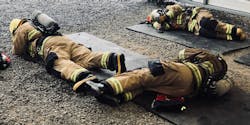One of the most common issues for new users of any SCBA system is SCBA claustrophobia. The unfamiliar sensation of a mask covering one’s face can make people feel as though their entire body is confined in a small space, even when they can see that they aren’t confined. This intense feeling can be made worse—even debilitating—during low-visibility training. People also might identify with the experience of feeling as though they are “breathing through a straw” when they exert a great deal of physical energy.
The truth is many experienced firefighters operate with mild to moderate anxiety while they wear SCBA.
The anxiety that’s caused by SCBA claustrophobia increases a person’s heart rate and respiratory drive, which throws off such an individual’s body’s natural homeostasis. Although there are numerous strategies to address this stress, the following two popular and well-researched breathing techniques often are used in stress and resiliency training inside and outside of the fire service. Once mastered, these techniques can be used while operating in an immediately dangerous to life and health environment to quickly reorient to the task at hand.
Breathing techniques
Box breathing is used by Navy SEALs during Basic Underwater Demolition/SEAL (BUD/S) training. The technique has been shown to decrease blood pressure, heart rate and respiratory rate. Box breathing also reverts one’s brain back into to the parasympathetic nervous system and out of the body’s fight-or-flight response to wearing the SCBA.
The basic idea of box breathing is inhaling for three seconds, holding your breath for three seconds, exhaling for three seconds and holding your breath for three seconds again before you start the cycle over, creating “the box.”
Box breathing can be used intentionally at the beginning of an operation to start your breath off on the right path. You then can call your focus back to “the box” periodically, keeping your anxiety at a workable level.
Another technique is belly breathing. This technique’s advantage is that the breath comes from below the chest and shoulder straps of the SCBA. This allows SCBA to be used without adding the feeling of tightness to your chest. Marine Corps snipers use this technique to lower their heart rate when they focus on a target.
To belly breathe, focus on pushing your stomach out during your inhale. Then, allow your stomach to return to normal during your exhale. This technique can be used quickly to shift focus onto your breath and away from your anxiety, reorienting yourself to your environment and your task.
Stress inoculation
Overcoming your discomfort with SCBA involves putting yourself in stressful situations while operating with your SCBA and practicing your new breathing techniques. The simple act of wearing a pack in full gear while engaging in any physical activity puts stress on your body and mind, particularly if you have anxiety from the outset. You can add other physical stress slowly and decrease your visibility while being on air to continue to build your skills and to become more comfortable. This inoculation is best done over time with the guidance of mentors and the eventual use of SCBA confidence courses.
While building up to this point, there is an easy exercise to add effective discomfort without being confined in an SCBA confidence trailer. I originally saw this method demonstrated in a lecture by stress-induced-anxiety-management expert Ric Jorge. Since then, I personally saw how it can be successfully applied to the issue of SCBA claustrophobia. Remember, while adding this discomfort, practice focusing on your breath with box breathing or belly breathing.
Begin by doing 10–20 pushups (or however many that you need to start to raise your pulse and respiratory drive). Then, lie on your stomach and focus on your breathing using one of the previously described techniques. This seems like a simple task, but often, just the weight of the SCBA can make it feel as though you’re trapped.
Remember, if it becomes too much, you can roll over or just stand up.
Start off doing this drill without turnouts, progressing into wearing your gear and then decreasing visibility with a mask insert. Challenge yourself by being able to lie in the prone position after the pushups for longer periods of time or by adding more physical exertion prior to the exercise.
After consistent use of this exercise, you should be able to start tackling drills and confidence courses with ease.
Don’t give up
One of the most effective drivers of success in the fire service is having a success-based mindset. In regard to SCBA claustrophobia, you must believe that you will decrease your anxiety; you must believe that you will become proficient in the use of your SCBA.
About the Author
Kenneth Stepien
Kenneth Stepien has been a proud second-generation firefighter since 2009. He served as a firefighter/paramedic in rural Illinois and suburban Chicagoland before relocating to the Pacific Northwest in 2015. Stepien worked for the Tacoma, WA, Fire Department where he served as a firefighter/EMT, a driver, a recruit school instructor and a lieutenant. In 2022, he joined the Seattle Fire Department.
